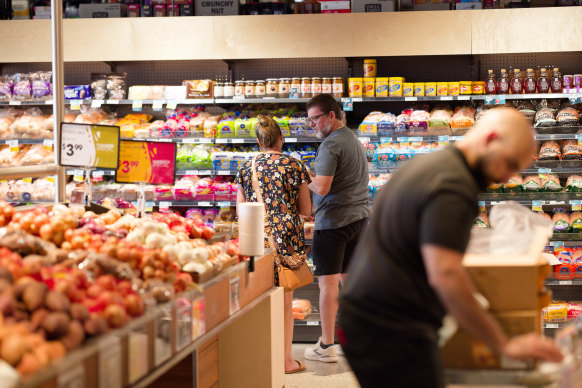This was published 1 year ago
Interest rates and inflation can’t stop another lift in house values
By Shane Wright
House values in parts of Australia have climbed almost 30 per cent over the past year despite high interest rates and cost-of-living pressures, but consumers are continuing to struggle as they cut the number of goods and services they buy.
Data from CoreLogic released on Friday shows that over the past month, dwelling values climbed another 0.6 per cent to be 8.9 per cent up over the past 12 months.

Dwelling values have continued to climb despite high inflation and interest rates.Credit: Dion Georgopoulos
House values in Sydney increased 0.4 per cent in February to be 11.7 per cent up over the year, with the median value now just short of $1.4 million. Gains have been stronger for units, with values up 12.2 per cent over the past year.
In Melbourne, house values rose by 0.1 per cent to be 4.4 per cent stronger since February last year. The median value for a house in the southern capital is $942,779.
Parts of the nation’s capitals have gone through much larger jumps in values. In Sydney, dwelling values in the Merrylands-Guildford area have risen by 15.7 per cent over the past 12 months while they increased by 15.2 per cent in Hornsby.
In Melbourne, values in the northern area of Darebin taking in suburbs such as Mont Park and Reservoir have risen by 9 per cent. The next strongest area in Melbourne is the eastern parts of Whitehorse, taking in Vermont and Heatherdale, where values have increased by 8.3 per cent.
These have been dwarfed by increases elsewhere. The largest increases have been in Perth where in the south-east suburb of Armadale, values have jumped by 28.6 per cent over the past year while in nearby Gosnells they have increased by 25.1 per cent.
In Brisbane, values in the southern suburb of Nathan have risen by 23.3 per cent while in the Springwood-Kingston area they have jumped by 22.5 per cent.
CoreLogic’s research director Tim Lawless said the ongoing increase in values reflected an imbalance between supply and demand across much of the country.
He said that while values had been resilient in the face of high interest rates and cost-of-living pressures, it would take substantial cuts for the market to take off.
“With housing affordability an ongoing challenge and lenders generally cautious towards borrowers with high debt-to-income or loan-to-income ratios, it’s hard to see a material lift in housing values until interest rates come down significantly,” he said.
Inflation data this week showing prices across a growing number of areas are falling or flatlining has encouraged economists and analysts to predict the Reserve Bank to start cutting interest rates in the second half of this year.
Figures from the Australian Bureau of Statistics released on Thursday, which showed retail sales rose by 1.1 per cent in January, highlighted the ongoing impact of cost-of-living pressures and higher interest rates on consumers.

Shoppers have had to reduce their purchases to deal with cost-of-living pressures.Credit: Trevor Collens
The increase was driven by higher spending on clothing and footwear, which rose by 2.4 per cent in the month, and on household goods which were up by 2.3 per cent.
The lift in January, however, was well short of market expectations as consumers had been tipped to sharply increase spending to welcome in the new year following a 2.1 per cent drop in December.
Spending has not increased since September and has only improved by 1.1 per cent since January last year, despite strong population growth and a lift in wage growth.
Callam Pickering, the Asia-Pacific economist with the Indeed job website, said the figures highlighted how consumers were reducing the number of goods and services they purchased.
“If monetary policy is data dependent then we can view these latest retail figures as yet more evidence that the next movement is likely to be down. Households are struggling and that is reflected in retail spending,” he said.
“Rate cuts in the second half of the year are increasingly plausible and there will be lots of discussion to that effect.”
Cut through the noise of federal politics with news, views and expert analysis. Subscribers can sign up to our weekly Inside Politics newsletter.